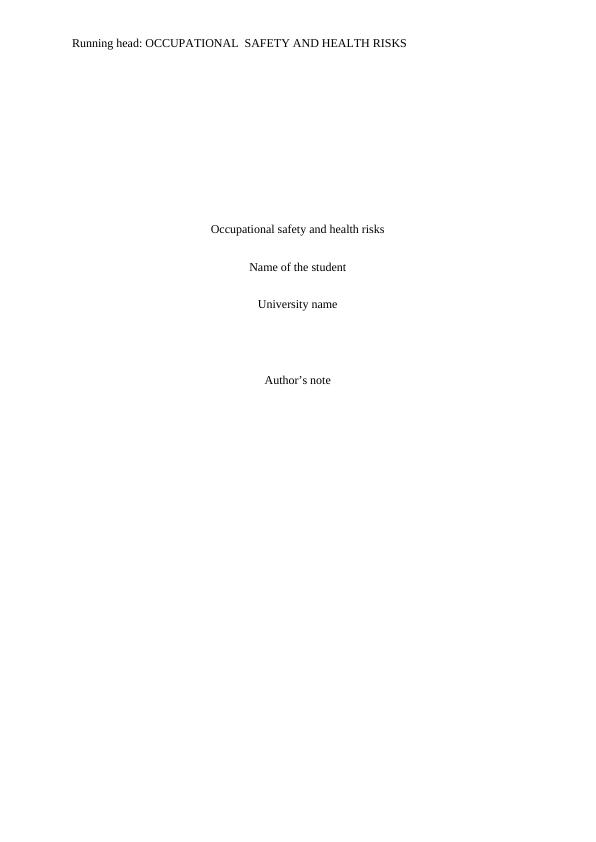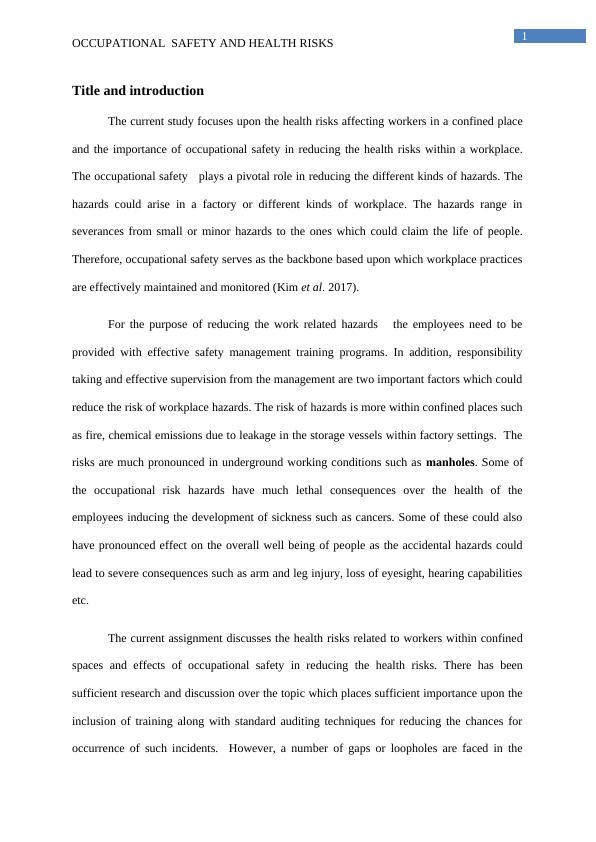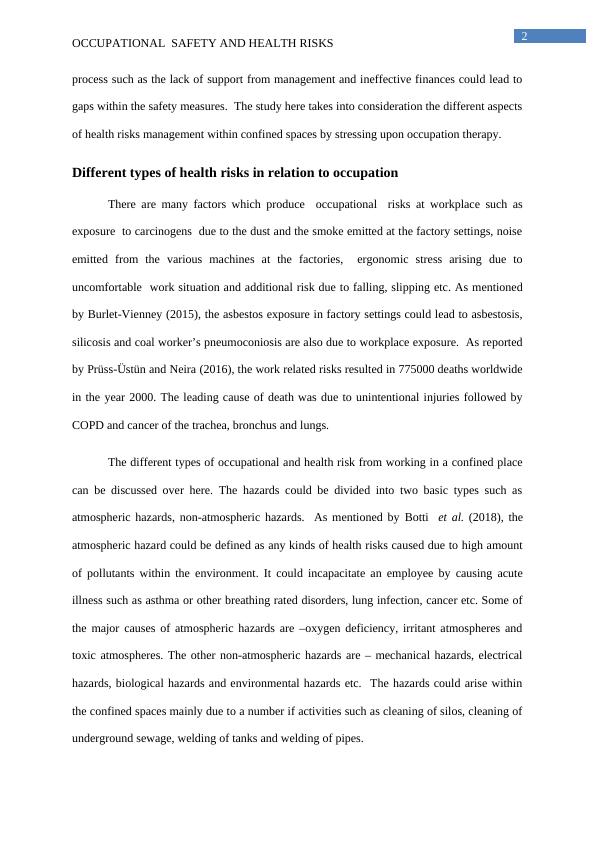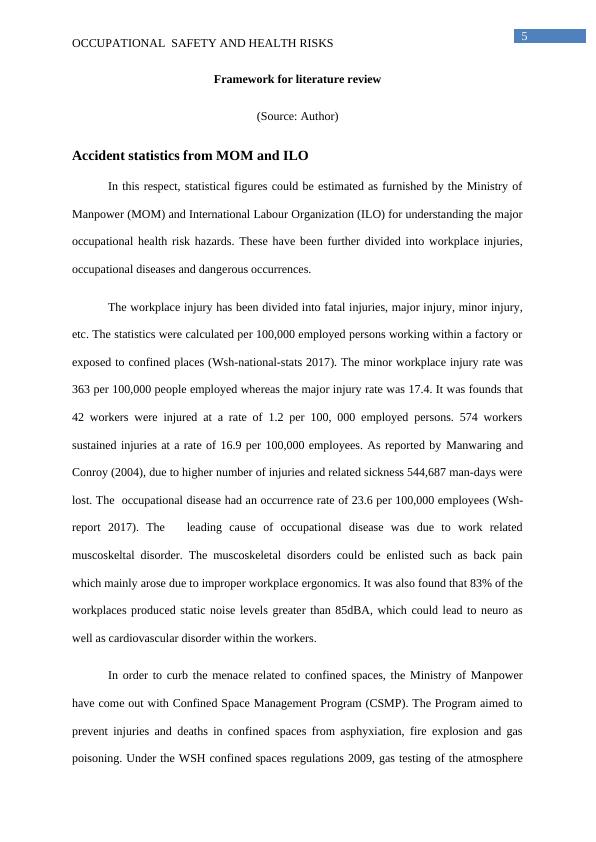Occupational Safety and Health Risks in Confined Spaces
27 Pages8375 Words479 Views
Added on 2023-06-10
About This Document
This study focuses on the health risks affecting workers in confined spaces and the importance of occupational safety in reducing them. The hazards range from minor to life-threatening, and effective safety management training programs and supervision from management are crucial. The study discusses different types of health risks and the need for personal protective equipment. The literature review highlights the gaps in safety measures and the importance of a positive work culture. The workplace health and safety framework is also discussed.
Occupational Safety and Health Risks in Confined Spaces
Added on 2023-06-10
ShareRelated Documents
Running head: OCCUPATIONAL SAFETY AND HEALTH RISKS
Occupational safety and health risks
Name of the student
University name
Author’s note
Occupational safety and health risks
Name of the student
University name
Author’s note

1
OCCUPATIONAL SAFETY AND HEALTH RISKS
Title and introduction
The current study focuses upon the health risks affecting workers in a confined place
and the importance of occupational safety in reducing the health risks within a workplace.
The occupational safety plays a pivotal role in reducing the different kinds of hazards. The
hazards could arise in a factory or different kinds of workplace. The hazards range in
severances from small or minor hazards to the ones which could claim the life of people.
Therefore, occupational safety serves as the backbone based upon which workplace practices
are effectively maintained and monitored (Kim et al. 2017).
For the purpose of reducing the work related hazards the employees need to be
provided with effective safety management training programs. In addition, responsibility
taking and effective supervision from the management are two important factors which could
reduce the risk of workplace hazards. The risk of hazards is more within confined places such
as fire, chemical emissions due to leakage in the storage vessels within factory settings. The
risks are much pronounced in underground working conditions such as manholes. Some of
the occupational risk hazards have much lethal consequences over the health of the
employees inducing the development of sickness such as cancers. Some of these could also
have pronounced effect on the overall well being of people as the accidental hazards could
lead to severe consequences such as arm and leg injury, loss of eyesight, hearing capabilities
etc.
The current assignment discusses the health risks related to workers within confined
spaces and effects of occupational safety in reducing the health risks. There has been
sufficient research and discussion over the topic which places sufficient importance upon the
inclusion of training along with standard auditing techniques for reducing the chances for
occurrence of such incidents. However, a number of gaps or loopholes are faced in the
OCCUPATIONAL SAFETY AND HEALTH RISKS
Title and introduction
The current study focuses upon the health risks affecting workers in a confined place
and the importance of occupational safety in reducing the health risks within a workplace.
The occupational safety plays a pivotal role in reducing the different kinds of hazards. The
hazards could arise in a factory or different kinds of workplace. The hazards range in
severances from small or minor hazards to the ones which could claim the life of people.
Therefore, occupational safety serves as the backbone based upon which workplace practices
are effectively maintained and monitored (Kim et al. 2017).
For the purpose of reducing the work related hazards the employees need to be
provided with effective safety management training programs. In addition, responsibility
taking and effective supervision from the management are two important factors which could
reduce the risk of workplace hazards. The risk of hazards is more within confined places such
as fire, chemical emissions due to leakage in the storage vessels within factory settings. The
risks are much pronounced in underground working conditions such as manholes. Some of
the occupational risk hazards have much lethal consequences over the health of the
employees inducing the development of sickness such as cancers. Some of these could also
have pronounced effect on the overall well being of people as the accidental hazards could
lead to severe consequences such as arm and leg injury, loss of eyesight, hearing capabilities
etc.
The current assignment discusses the health risks related to workers within confined
spaces and effects of occupational safety in reducing the health risks. There has been
sufficient research and discussion over the topic which places sufficient importance upon the
inclusion of training along with standard auditing techniques for reducing the chances for
occurrence of such incidents. However, a number of gaps or loopholes are faced in the

2
OCCUPATIONAL SAFETY AND HEALTH RISKS
process such as the lack of support from management and ineffective finances could lead to
gaps within the safety measures. The study here takes into consideration the different aspects
of health risks management within confined spaces by stressing upon occupation therapy.
Different types of health risks in relation to occupation
There are many factors which produce occupational risks at workplace such as
exposure to carcinogens due to the dust and the smoke emitted at the factory settings, noise
emitted from the various machines at the factories, ergonomic stress arising due to
uncomfortable work situation and additional risk due to falling, slipping etc. As mentioned
by Burlet-Vienney (2015), the asbestos exposure in factory settings could lead to asbestosis,
silicosis and coal worker’s pneumoconiosis are also due to workplace exposure. As reported
by Prüss-Üstün and Neira (2016), the work related risks resulted in 775000 deaths worldwide
in the year 2000. The leading cause of death was due to unintentional injuries followed by
COPD and cancer of the trachea, bronchus and lungs.
The different types of occupational and health risk from working in a confined place
can be discussed over here. The hazards could be divided into two basic types such as
atmospheric hazards, non-atmospheric hazards. As mentioned by Botti et al. (2018), the
atmospheric hazard could be defined as any kinds of health risks caused due to high amount
of pollutants within the environment. It could incapacitate an employee by causing acute
illness such as asthma or other breathing rated disorders, lung infection, cancer etc. Some of
the major causes of atmospheric hazards are –oxygen deficiency, irritant atmospheres and
toxic atmospheres. The other non-atmospheric hazards are – mechanical hazards, electrical
hazards, biological hazards and environmental hazards etc. The hazards could arise within
the confined spaces mainly due to a number if activities such as cleaning of silos, cleaning of
underground sewage, welding of tanks and welding of pipes.
OCCUPATIONAL SAFETY AND HEALTH RISKS
process such as the lack of support from management and ineffective finances could lead to
gaps within the safety measures. The study here takes into consideration the different aspects
of health risks management within confined spaces by stressing upon occupation therapy.
Different types of health risks in relation to occupation
There are many factors which produce occupational risks at workplace such as
exposure to carcinogens due to the dust and the smoke emitted at the factory settings, noise
emitted from the various machines at the factories, ergonomic stress arising due to
uncomfortable work situation and additional risk due to falling, slipping etc. As mentioned
by Burlet-Vienney (2015), the asbestos exposure in factory settings could lead to asbestosis,
silicosis and coal worker’s pneumoconiosis are also due to workplace exposure. As reported
by Prüss-Üstün and Neira (2016), the work related risks resulted in 775000 deaths worldwide
in the year 2000. The leading cause of death was due to unintentional injuries followed by
COPD and cancer of the trachea, bronchus and lungs.
The different types of occupational and health risk from working in a confined place
can be discussed over here. The hazards could be divided into two basic types such as
atmospheric hazards, non-atmospheric hazards. As mentioned by Botti et al. (2018), the
atmospheric hazard could be defined as any kinds of health risks caused due to high amount
of pollutants within the environment. It could incapacitate an employee by causing acute
illness such as asthma or other breathing rated disorders, lung infection, cancer etc. Some of
the major causes of atmospheric hazards are –oxygen deficiency, irritant atmospheres and
toxic atmospheres. The other non-atmospheric hazards are – mechanical hazards, electrical
hazards, biological hazards and environmental hazards etc. The hazards could arise within
the confined spaces mainly due to a number if activities such as cleaning of silos, cleaning of
underground sewage, welding of tanks and welding of pipes.

3
OCCUPATIONAL SAFETY AND HEALTH RISKS
There could be a number of health risks associated with people working within
confined spaces such as manholes. The manhole provides a unique environment to the people
working over there. The risk often arises due to flash or blasts within confined spaces. It has
been found cables and conductors in a manhole operate under high voltage. The insulation
and old cables can become brittle and subject to splices within the wet and congested
environment. The existing cables and splices can cause physical damage to individual be
generating arcing fault. As commented by Boyle (2015), the contact with exposed, energised
electrical conductors or circuit parts operating at 50 volts or more could cause physical
damage to the employees. As per the Occupational Safety and Health Administration (OSHA)
guidelines, the workers performing under strict and closed environments such as manhole
should be provided with personal protective equipments Level 4.This level of protection is
mainly offered to people working in decontamination areas. It is suitable for an environment
which offers lowest level of respiratory and skin protection.
Framework of the review
The literature review is a systematic procedure and is based upon an extensive search
criterion which has been followed over here. For instance, a number of secondary databases
such as NCBI, ELSEVIER etc have been searched for gathering of the required articles. For
searching of the articles a number of extensive keywords have been used which are
occupational hazards, confined places hazard, manhole hazards, workplace hazards
management. The articles which have been extracted through the detailed research of the
keywords only have been taken into consideration. The rest have been eliminated for the
purpose of removing the confounding biases.
Additionally, a number of filters have been applied for finding out the research
articles such as the articles which have been printed in English only have been taken into
OCCUPATIONAL SAFETY AND HEALTH RISKS
There could be a number of health risks associated with people working within
confined spaces such as manholes. The manhole provides a unique environment to the people
working over there. The risk often arises due to flash or blasts within confined spaces. It has
been found cables and conductors in a manhole operate under high voltage. The insulation
and old cables can become brittle and subject to splices within the wet and congested
environment. The existing cables and splices can cause physical damage to individual be
generating arcing fault. As commented by Boyle (2015), the contact with exposed, energised
electrical conductors or circuit parts operating at 50 volts or more could cause physical
damage to the employees. As per the Occupational Safety and Health Administration (OSHA)
guidelines, the workers performing under strict and closed environments such as manhole
should be provided with personal protective equipments Level 4.This level of protection is
mainly offered to people working in decontamination areas. It is suitable for an environment
which offers lowest level of respiratory and skin protection.
Framework of the review
The literature review is a systematic procedure and is based upon an extensive search
criterion which has been followed over here. For instance, a number of secondary databases
such as NCBI, ELSEVIER etc have been searched for gathering of the required articles. For
searching of the articles a number of extensive keywords have been used which are
occupational hazards, confined places hazard, manhole hazards, workplace hazards
management. The articles which have been extracted through the detailed research of the
keywords only have been taken into consideration. The rest have been eliminated for the
purpose of removing the confounding biases.
Additionally, a number of filters have been applied for finding out the research
articles such as the articles which have been printed in English only have been taken into

4
OCCUPATIONAL SAFETY AND HEALTH RISKS
consideration. The articles which have been printed in any other language have been
eliminated. Moreover, the articles which have been published within the last 15 years only
have been taken into consideration. The ones which have been published prior to that have
been eliminating. For the purpose of the analysis the articles have been grouped into similar
dissimilar ideas which have been further grouped into themes. These have been used for
doing thematic analysis, which helps in arriving at a particular point.
50 records identified through database
searching
30 records after duplicate removal
22 records screened
14 full text articles assessed for
eligibility
8 qualitative articles
6 quantitative articles
12 additional records identified
through other sources
8 records excluded
4 full text articles
excluded due to
irrelevance
OCCUPATIONAL SAFETY AND HEALTH RISKS
consideration. The articles which have been printed in any other language have been
eliminated. Moreover, the articles which have been published within the last 15 years only
have been taken into consideration. The ones which have been published prior to that have
been eliminating. For the purpose of the analysis the articles have been grouped into similar
dissimilar ideas which have been further grouped into themes. These have been used for
doing thematic analysis, which helps in arriving at a particular point.
50 records identified through database
searching
30 records after duplicate removal
22 records screened
14 full text articles assessed for
eligibility
8 qualitative articles
6 quantitative articles
12 additional records identified
through other sources
8 records excluded
4 full text articles
excluded due to
irrelevance

5
OCCUPATIONAL SAFETY AND HEALTH RISKS
Framework for literature review
(Source: Author)
Accident statistics from MOM and ILO
In this respect, statistical figures could be estimated as furnished by the Ministry of
Manpower (MOM) and International Labour Organization (ILO) for understanding the major
occupational health risk hazards. These have been further divided into workplace injuries,
occupational diseases and dangerous occurrences.
The workplace injury has been divided into fatal injuries, major injury, minor injury,
etc. The statistics were calculated per 100,000 employed persons working within a factory or
exposed to confined places (Wsh-national-stats 2017). The minor workplace injury rate was
363 per 100,000 people employed whereas the major injury rate was 17.4. It was founds that
42 workers were injured at a rate of 1.2 per 100, 000 employed persons. 574 workers
sustained injuries at a rate of 16.9 per 100,000 employees. As reported by Manwaring and
Conroy (2004), due to higher number of injuries and related sickness 544,687 man-days were
lost. The occupational disease had an occurrence rate of 23.6 per 100,000 employees (Wsh-
report 2017). The leading cause of occupational disease was due to work related
muscoskeltal disorder. The muscoskeletal disorders could be enlisted such as back pain
which mainly arose due to improper workplace ergonomics. It was also found that 83% of the
workplaces produced static noise levels greater than 85dBA, which could lead to neuro as
well as cardiovascular disorder within the workers.
In order to curb the menace related to confined spaces, the Ministry of Manpower
have come out with Confined Space Management Program (CSMP). The Program aimed to
prevent injuries and deaths in confined spaces from asphyxiation, fire explosion and gas
poisoning. Under the WSH confined spaces regulations 2009, gas testing of the atmosphere
OCCUPATIONAL SAFETY AND HEALTH RISKS
Framework for literature review
(Source: Author)
Accident statistics from MOM and ILO
In this respect, statistical figures could be estimated as furnished by the Ministry of
Manpower (MOM) and International Labour Organization (ILO) for understanding the major
occupational health risk hazards. These have been further divided into workplace injuries,
occupational diseases and dangerous occurrences.
The workplace injury has been divided into fatal injuries, major injury, minor injury,
etc. The statistics were calculated per 100,000 employed persons working within a factory or
exposed to confined places (Wsh-national-stats 2017). The minor workplace injury rate was
363 per 100,000 people employed whereas the major injury rate was 17.4. It was founds that
42 workers were injured at a rate of 1.2 per 100, 000 employed persons. 574 workers
sustained injuries at a rate of 16.9 per 100,000 employees. As reported by Manwaring and
Conroy (2004), due to higher number of injuries and related sickness 544,687 man-days were
lost. The occupational disease had an occurrence rate of 23.6 per 100,000 employees (Wsh-
report 2017). The leading cause of occupational disease was due to work related
muscoskeltal disorder. The muscoskeletal disorders could be enlisted such as back pain
which mainly arose due to improper workplace ergonomics. It was also found that 83% of the
workplaces produced static noise levels greater than 85dBA, which could lead to neuro as
well as cardiovascular disorder within the workers.
In order to curb the menace related to confined spaces, the Ministry of Manpower
have come out with Confined Space Management Program (CSMP). The Program aimed to
prevent injuries and deaths in confined spaces from asphyxiation, fire explosion and gas
poisoning. Under the WSH confined spaces regulations 2009, gas testing of the atmosphere

End of preview
Want to access all the pages? Upload your documents or become a member.
Related Documents
Risk Assessment Plan for the Eastman Chemical Companylg...
|17
|3571
|96
Occupational Health And Safety Assignmentlg...
|11
|2200
|517
Risk Perception and Communication Reportlg...
|14
|4100
|89
Standard operating procedures and occupational health and safety program : Assignmentlg...
|8
|2092
|222
Hazardous Chemical Exposure to US Workers and Global Industrial Workerslg...
|5
|673
|80
Work Place Hazard in Nursing: Types and Recommendationslg...
|16
|1157
|449
